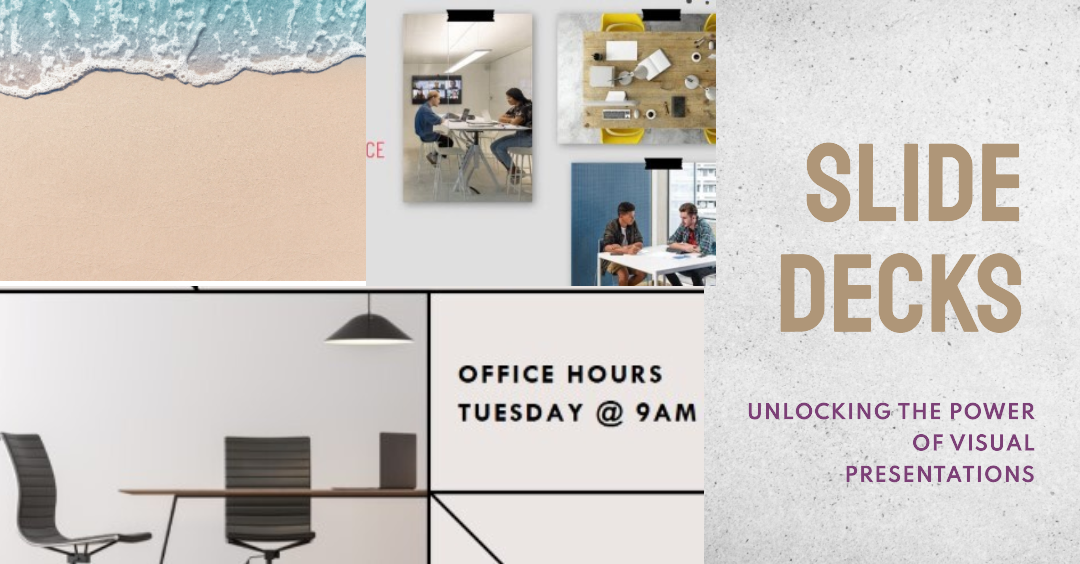In today’s fast-paced world, effective communication is paramount. Whether you’re delivering a presentation at work, pitching an idea to investors, or teaching a class, the use of visual aids can significantly enhance your message. Enter the slide deck—a versatile and powerful tool that has become a staple in the realm of presentations. In this article, we unravel the concept of slide decks, exploring their purpose, structure, and best practices to help you master the art of visual storytelling.
Defining Slide Decks
A slide deck is a collection of individual slides that combine text, images, charts, and multimedia elements to support and illustrate a presenter’s message. It serves as a visual aid to engage, inform, and persuade audiences during live presentations. Slide decks are typically created using presentation software like Microsoft PowerPoint, Apple Keynote, or Google Slides.
Purpose and Benefits
Slide decks serve a variety of purposes and offer several benefits, including:
- Enhancing Communication: Slide decks provide a visual representation of ideas, making complex concepts more accessible and memorable. They help speakers maintain audience attention and deliver a cohesive narrative.
- Organizing Information: A well-structured slide deck allows presenters to organize their content in a logical manner. The use of headings, bullet points, and sub-points helps to break down information into digestible chunks, aiding comprehension and retention.
- Visual Appeal: Incorporating visually appealing elements like images, graphs, and icons can significantly enhance the aesthetic appeal of a slide deck. Well-designed slides create a professional and engaging atmosphere, capturing the audience’s attention.
- Supporting Storytelling: Slide decks can serve as visual storytellers, supporting the presenter’s narrative with compelling visuals and concise text. They enable speakers to convey their message more effectively, facilitating understanding and emotional connection.
Structure and Best Practices
To create an impactful slide deck, it is essential to consider the following best practices:
- Clear and Concise Content: Each slide should convey a single key point or idea. Use short, focused sentences and bullet points to ensure clarity and avoid overwhelming the audience with excessive information.
- Visual Cohesion: Maintain a consistent visual theme throughout the slide deck by using a coherent color palette, font styles, and layout. Consistency creates a cohesive and professional impression.
- Engaging Visuals: Incorporate relevant and high-quality visuals to support your message. Images, charts, graphs, and diagrams can effectively convey information and create an emotional connection with the audience.
- Minimal Text: Avoid overcrowding slides with excessive text. Use keywords, phrases, or short sentences to convey your main points. Your spoken words should provide context and elaboration.
- Simplified Design: Opt for clean and uncluttered slide designs. Avoid distracting animations, excessive transitions, or unnecessary sound effects that can detract from your message.
- Practice and Rehearse: Familiarize yourself with the flow of your slide deck and rehearse your presentation. This will help you deliver your content smoothly and confidently, ensuring that your slides support your spoken words.
Best Practices for Designing Effective Slide Deck
When it comes to creating effective slide decks, there are some best practices that should be followed in order to ensure that your presentation is engaging and informative. First and foremost, it is important to keep in mind the purpose of your presentation and focus on creating a clear and visually appealing design that will help to communicate your message.
When it comes to the design of your slide deck, it is important to create a structure that is easy to follow and makes sense to the audience. You want to ensure that the slides are organized logically, with each slide building on the previous one. A great way to do this is to use a consistent color scheme and design elements throughout the presentation to create an overall cohesive look.
In addition to the structure of your slide deck, it is important to pay attention to the content. Keep it simple and make sure that the text is easy to read. Break up large blocks of text with visuals and use bullet points to highlight key points. Additionally, be sure to include only the most relevant and necessary information and avoid using too many slides.
Finally, when it comes to designing effective slide decks, it is important to remember that visuals are key. Incorporate visuals, such as photographs, illustrations, charts, and graphs, to help illustrate your points and engage your audience. Make sure that these visuals are clear, relevant, and easy to understand.
Tips for Delivering Engaging Slide Deck Presentations
Delivering an engaging slide deck presentation is an important part of the presentation process, and there are a few tips that can help you ensure that your presentation is successful.
First and foremost, it is important to practice your presentation beforehand. This will help you become familiar with the content and practice your delivery. Additionally, think about how you can use visuals to help illustrate your points and consider ways that you can use your voice and body language to engage your audience.
When it comes to delivering your presentation, start by introducing yourself and the content you’re about to cover. This will help to create a connection between you and your audience, and will also help to set the tone for the presentation. Additionally, remember to be mindful of your pace and speak clearly and confidently.
It is also important to be interactive and engage with your audience. Ask the audience questions and encourage discussion. This will help to keep them engaged and create a more meaningful presentation. Additionally, be sure to keep eye contact with your audience and use hand gestures to emphasize points.
Finally, be sure to end your presentation with a summary of the key points you covered. This will help to reinforce the message and ensure that your audience leaves with a clear understanding of what you presented.
Conclusion
Slide decks are a powerful tool for effective communication, enabling presenters to engage, inform, and persuade their audiences. By combining visually appealing elements with concise and focused content, slide decks bring clarity and impact to presentations. Understanding the purpose and best practices of creating slide decks empowers individuals to deliver compelling messages that resonate with their audiences.






